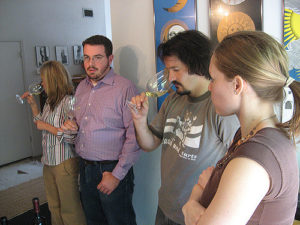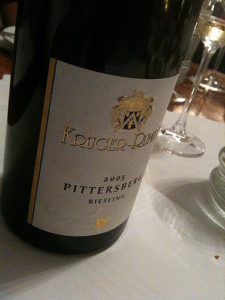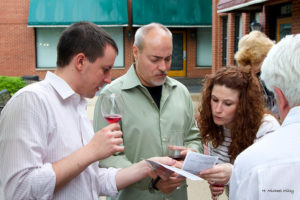“Minerality” is a tricky thing. It’s a term common in wine tasting notes, though its origins and causes remain uncertain and contentious. Scientific consensus for minerality is lacking, and there doesn’t seem to be much peer-reviewed science supporting a chemical or physical mechanism.

Photo courtesy Flickr user Jason Weaver
The term “minerality” itself is relatively new, with most references to the term occurring in the past 20 years or so. One study examining the evolution of “minerality” in French literature found associations between the word “minéralité” (minerality) and “vin” (wine) had increased after 1985, which according to the researchers was the start of the terms’ popularity growth.
Despite the lack of consensus as to what minerality is, there are several trains of thought that occur in both consumer lexicon as well as scientific literature. For the most part, “minerality” is used to describe aromatic characteristics of a wine. Common terms appearing in consumer and scientific literature include flint, chalk, wet stone, graphite, or smoky.
Others associate minerality with “saltiness” or acidity in wine, though this association is not a common one, and some have argued that this association is more of “mistaken identity” with other aromatic characteristics or faults.
Another association for minerality and wine relates to the soil or terroir where the grapes were grown. Soil is known to influence wine composition, though this influence is often indirect and thereby very difficult to form any scientific links. Soil can significantly influence how well a grapevine grows, and how the grapes on those vines develop, though pinpointing direct mechanisms between something in the soil and a compound in the finished wine that can be tied to minerality has been unsuccessful thus far.
A new study, published in December 2016 in the journal Food Research International, aimed to evaluate how consumers define or understand the concept of minerality, and how these concepts relate to how wine professionals and those in the scientific community understand it.
Brief Methods
This study used an online survey: a section with open-ended questions allowing participants to freely define the concept of minerality as it relates to wine, and a section with closed-ended questions that included those related to sociodemographics, wine knowledge, and wine purchase behaviors.
Surveys were circulated to participants in France and the French-speaking region of Switzerland between 2011-2012.
There were 1697 participants total, with 1344 from France and 353 from the French-speaking region of Switzerland.
A program called “TreeTagger” was used to evaluate the wordy open-ended questions, the results of which were then compared to the answers from the closed-ended questions to determine specific groups or clusters of consumers with unique understanding of the concept of minerality.

Photo courtesy Flickr user atl10trader
Selected Results
- 10 separate groups of consumers were identified based on the analysis, which are referred to as G1 through G10:
- G1: 173 participants;
- 24.3% self-reported as wine beginners (vs. 17.51% of the total pool).
- The terms “earth” and “earthy taste” were the most commonly used terms for this group.
- G2: “Soil and Terroir Group 1”; 210 participants.
- Minerality was associated with the concept of “terroir” for this group.
- “Taste” was a common term used, specifically when coupled with terroir(“taste of terroir”).
- Sensory terms like “aroma”, “taste”, “stone”, “pebble”, “rock”, and “earth” were often used in this group.
- 45.71% were between the ages of 50-70 (vs. 27.38% of the total participant pool).
- Participants in this group frequently purchased wine directly from the winery.
- 29.5% claimed growing region was the primary driver of purchase.
- 36.2% claimed to be “wine lovers” (vs. 30.8% of the total participant pool).
- G3: “Soil and Terroir Group 2”; 133 participants.
- Minerality was often associated with “the place where vines grow” for this group.
- “Soil” was a frequently used term for this group, particularly when the terms “vine”, “grow”, “wine”, and “be” were also used.
- There were no significant sociodemographic or purchase behavior characteristics identified for this group.
- G4: 106 participants.
- This group associated minerality with general “aroma”, and not any particular kind of aroma.
- 57.5% self-reported as wine amateurs(vs. 49.8% of the total pool).
- G4, G5, and G8 were close together in cluster analysis.
- G5: 126 participants.
- Participants in this group gave the longest responses to open-ended questions.
- Terms used in all the other groups were also used frequently in this group (like “soil”, “aroma”, “taste”, and other sensory characteristics already mentioned above and below).
- Minerality appeared to be a multi-dimensional concept for this group.
- The majority of participants in this group were men.
- 49.2% purchased wine directly from the winery (vs. 15.46% of the total pool).
- 5.6% self-reported as experts (vs. 1.9% of the total pool).
- G6: “The Olfactory Group”; 199 participants.
- Specific aromas were often cited by this group, including “stone”, “gun”, and “flint”, with “stone” being the most commonly used.
- Other aromatic and sensory characteristics often cited by this group included “earth”, “pebble”, “granite”, “soil”, “rock”, “limestone”, “taste”, “aroma”, “dry”, “acidity”, “odor”, “mouth”, and “freshness”.
- 51.76% self-reported as “wine lovers” (vs. 30.81% of the total pool).
- 52.76% purchased their wines directly from the winery (vs. 15.46% of the total pool).
- 19.1% never purchased wine in the supermarket.
- G7: “The Uninformed Group”; 244 participants.
- This group appeared to not have much understanding of what minerality in wine meant.
- 28.28% considered themselves wine beginners (vs. 17.51% of the total pool).
- Price of wine was the main factor for purchase decisions for this group, with 27.87% choosing it as the primary factor (vs. 16.49% of the total pool).
- 27.05% never purchased wine directly from the winery(vs. 15.46% of the total pool).
- 23.77% have purchased wine directly from the winery (vs. 37.24% of the total pool).
- G8: 217 participants.
- This group emphasized “dry white wine” when defining minerality.
- 38.7% self-reported as “wine lovers” (vs. 30.8% of the total pool).
- G9: “The Mineral Ions Group”; 130 participants.
- Frequently used the verb “to contain” as well as the term “mineral ions”.
- Minerals and ions were associated together two ways for this group: 1stin reference to a comparison with mineral water and the 2nd in reference to ions found in the soil.
- 67.7% were women (vs. 52.3% of the total pool).
- 46.15% were between the ages of 20-30 (vs. 25.21% of the total pool).
- 30.77% never purchased wine directly from the winery (vs. 15.46% of the total pool).
- 41.54% often purchased wine from the supermarket (vs. 27.14% of the total pool).
- G10: 124 participants.
- Participant understanding of the concept of minerality was vague for this group, with the phrase “it reminds me of” used frequently.
- 41.9% were between the ages of 20-30 (vs. 25.21% of the total pool).
- G1: 173 participants;
Conclusions

Photo courtesy Flickr user H. Michael Miley
According to the researchers, 5 main themes arose from this study:
- Though minerality is a term often used by wine professionals, 1/5 of study participants didn’t understand the concept. These consumers would most often associate other things like specific sensory characteristics or the concept of terroir when describing minerality.
- It was clear to participants that minerality was a sensory characteristic often used when describing the aromas of wine. Participants often linked minerality to aromatic characteristics like “flint”, “chalk”, or “stone”, as well as organoleptic characteristics like “acidity” and “freshness”.
- The results indicated differences in terms used depending upon level of reported wine expertise. Those with more wine knowledge used more specific terms when describing minerality, while those with less wine knowledge were more vague.
- For 1/5 of participants in this study, minerality was linked to the relationship between the soil and the grapevine, or terroir specifically for 13% of participants. These participants tended to be older and possessed a great deal of wine knowledge.
One interesting aside the researchers found is that when the term “minerality” first peaked in French wine literature in 1994, the term “terroir” began its decline. They speculated that “minerality” may be a sort of replacement for “terroir”, since “minerality” appears to be unique to wine while “terroir” has become a concept adopted by many other agricultural products.
- Finally, minerality was linked to mineral ions for some of the participants in this study. These participants tended to be younger women with little wine knowledge, so this association might be a sort of confusion on their part with ions in mineral water, simply due to the similarity of the terms, since they might be more familiar with the former.
This study confirmed the confusion as to what minerality in wine actually is, and that depending upon one’s level of expertise, that understanding will vary. It’s important to remember that participants in this study were French or Swiss French-speaking, therefore the results may not be applicable to other cultures.
So, while this study confirmed that minerality is confusing, it does start to get at how minerality is perceived by more specific groups based on various sociodemographic characteristics.
Sources:

2 comments for “What IS Minerality, Anyway?: An Evaluation of Consumer Understanding of Minerality Using Analysis of Language”